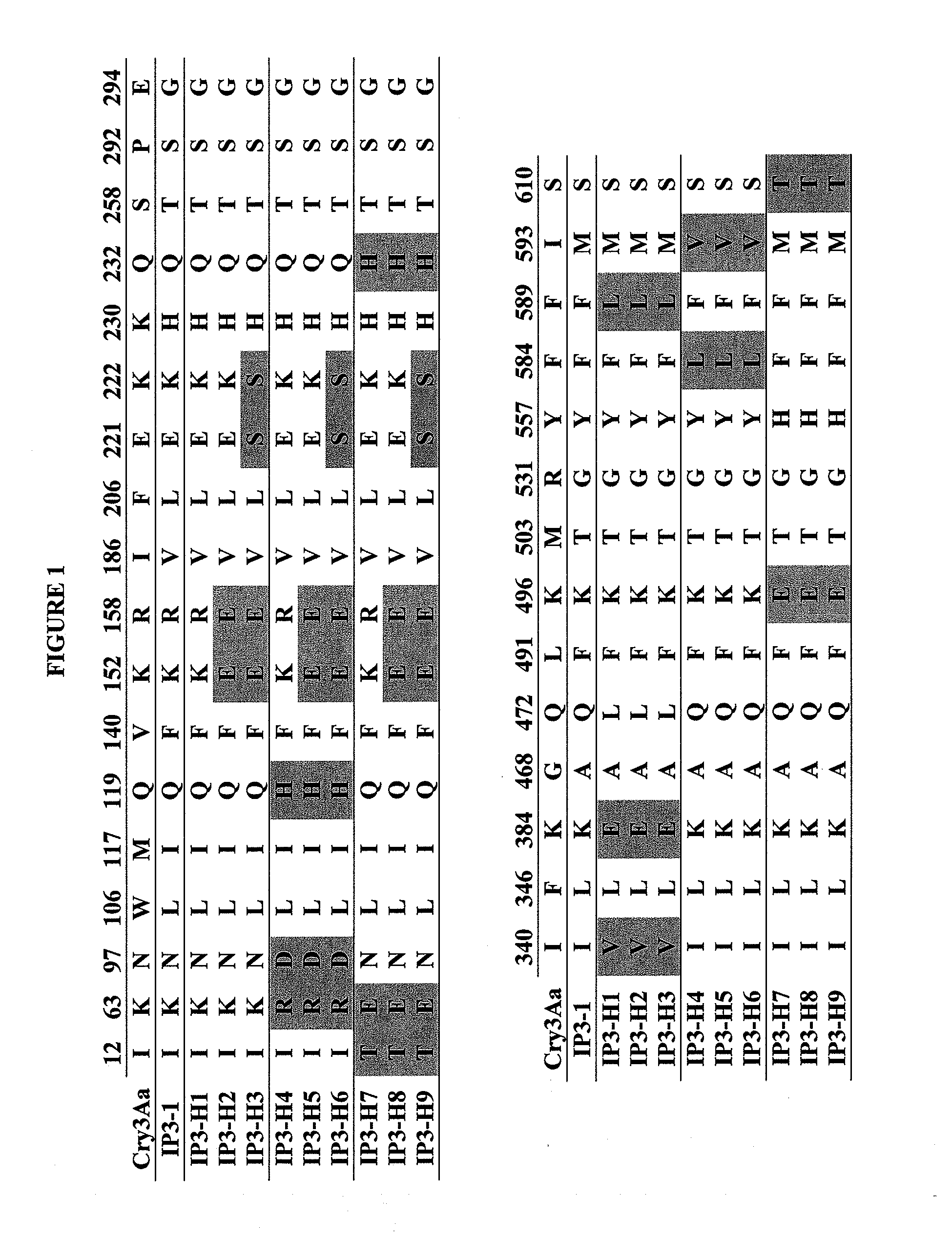Synthetic insecticidal proteins active against corn rootworm
a technology of insecticidal proteins and corn rootworms, applied in the field of plant molecular biology and plant pest control, can solve the problems of corn rootworm larvae destroying significant percentages of corn rootworms, affecting the survival of corn rootworms, and affecting the survival of corn rootworm larvae, so as to improve enhance the effect of pesticidal activity
- Summary
- Abstract
- Description
- Claims
- Application Information
AI Technical Summary
Benefits of technology
Problems solved by technology
Method used
Image
Examples
example 1
IP3-1 Sequence Design
[0183]In order to introduce the amino acid sequence diversity to Cry3Aa, a new Cry3-type protein called IP3-1 was designed in silico. In the design process for introducing certain diversities to Cry3Aa, modest changes such as 1→V, L→F, K→H, G→A were made which are expected to induce very small changes in the protein structure. Such structural changes may contribute to higher activity when combined with additional diversity introduced by shuffling.
[0184]In order to design IP3-1, all available naturally occurring Cry3 peptide sequences were aligned. The Cry3 sequence was scanned residue by residue to find specific residues that differ among Cry3 proteins. These diversified residues found on Cry3Aa were changed one by one to another residue found in other Cry3 proteins. Each mutation was evaluated structurally by computer to assure structural integrity of the polypeptide. The 3-dimensional conformation of the Cry3Aa derivative was predicted from its amino acid sequ...
example 2
Generation of IP3 Variant Plant Transformation Constructs
[0192]The protein sequences of IP3 variants, H2 (SEQ ID NO: 8), H3 (SEQ ID NO: 1), H5 (SEQ ID NO: 11), H6 (SEQ ID NO: 2), H8 (SEQ ID NO: 14) and H9 (SEQ ID NO: 3) were backtranslated and optimized for expression in maize. The resulting sequences H2 (SEQ ID: 7), H3 (SEQ ID: 9), H5 (SEQ ID: 10), H6 (SEQ ID NO: 12), H8 (SEQ ID NO: 13) and H9 (SEQ ID NO; 15) were synthesized by Genscript USA Corp (Piscataway, N.J.) with BamHI and SnaBI restriction enzyme sites at the 5′- and 3′ ends respectively. Each variant was subcloned as a BamHI-SnaBI fragment into a Gateway entry vector containing a plant expression cassette with the maize Ubiquitin1 promoter-5′UTR-intron combination (UBIZM PRO-UBIZM-5UTR-UBIZM INTRON) and the potato PIN II terminator sequence. The resulting plant expression cassette contains the following components operatively linked together in this order; UBIZM PRO-UBIZM-5UTR-UBIZM INTRON, the IP3-variant gene, and the P...
example 3
Agrobacterium-Mediated Transformation of Maize and Regeneration of Transgenic Plants
[0193]For Agrobacterium-mediated transformation of maize transformation vectors containing the IP3 variants, the method of Zhao was employed (U.S. Pat. No. 5,981,840, and international patent publication WO98 / 32326; the contents of each are hereby incorporated by reference in its entirety). Briefly, immature embryos were isolated from maize and the embryos contacted with a suspension of Agrobacterium transformed with the IP3 variant plant transformation construct under conditions whereby the bacteria were capable of transferring the gene sequences of the invention to at least one cell of at least one of the immature embryos (step 1: the infection step). In this step, the immature embryos were immersed in an Agrobacterium suspension for the initiation of inoculation. The embryos were co-cultured for a time with the Agrobacterium (step 2: the co-cultivation step). The immature embryos were cultured on ...
PUM
| Property | Measurement | Unit |
|---|---|---|
| pH | aaaaa | aaaaa |
| area | aaaaa | aaaaa |
| area | aaaaa | aaaaa |
Abstract
Description
Claims
Application Information
 Login to View More
Login to View More - R&D
- Intellectual Property
- Life Sciences
- Materials
- Tech Scout
- Unparalleled Data Quality
- Higher Quality Content
- 60% Fewer Hallucinations
Browse by: Latest US Patents, China's latest patents, Technical Efficacy Thesaurus, Application Domain, Technology Topic, Popular Technical Reports.
© 2025 PatSnap. All rights reserved.Legal|Privacy policy|Modern Slavery Act Transparency Statement|Sitemap|About US| Contact US: help@patsnap.com

